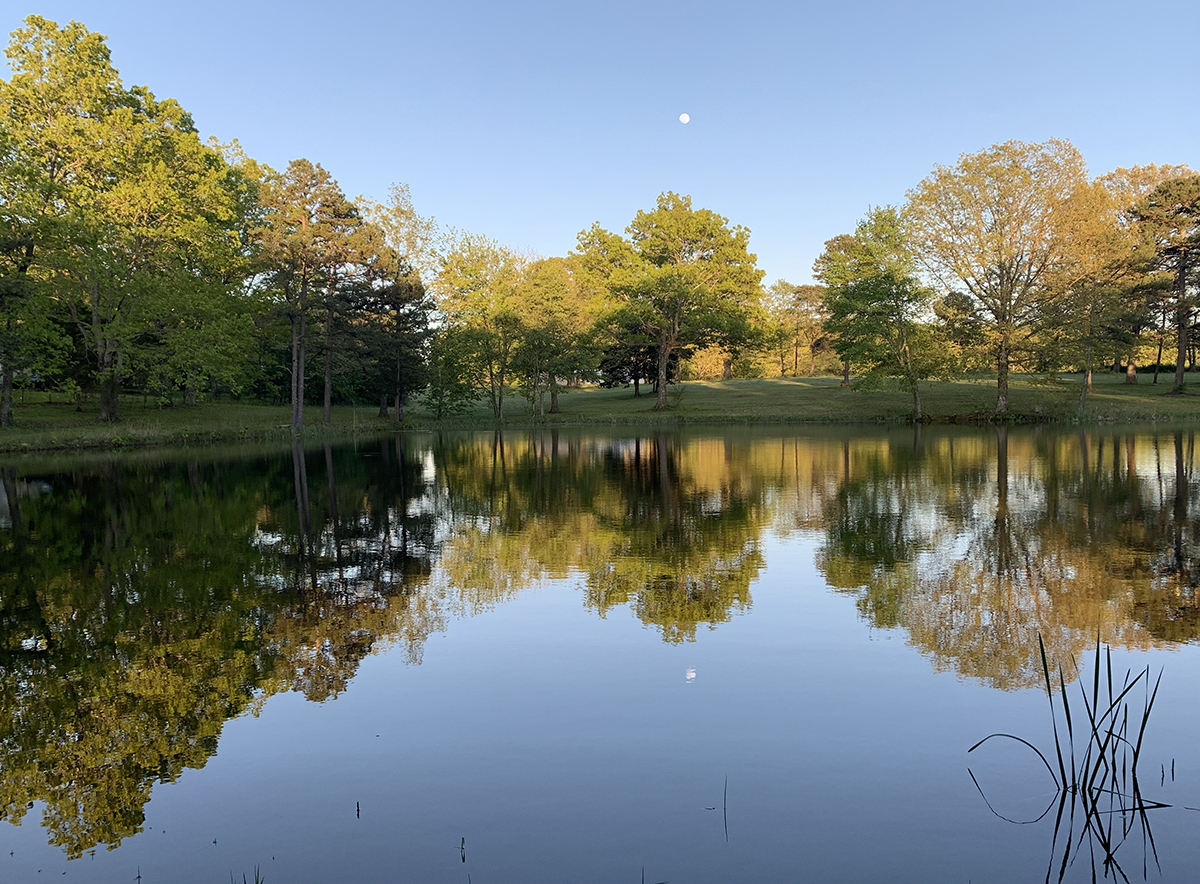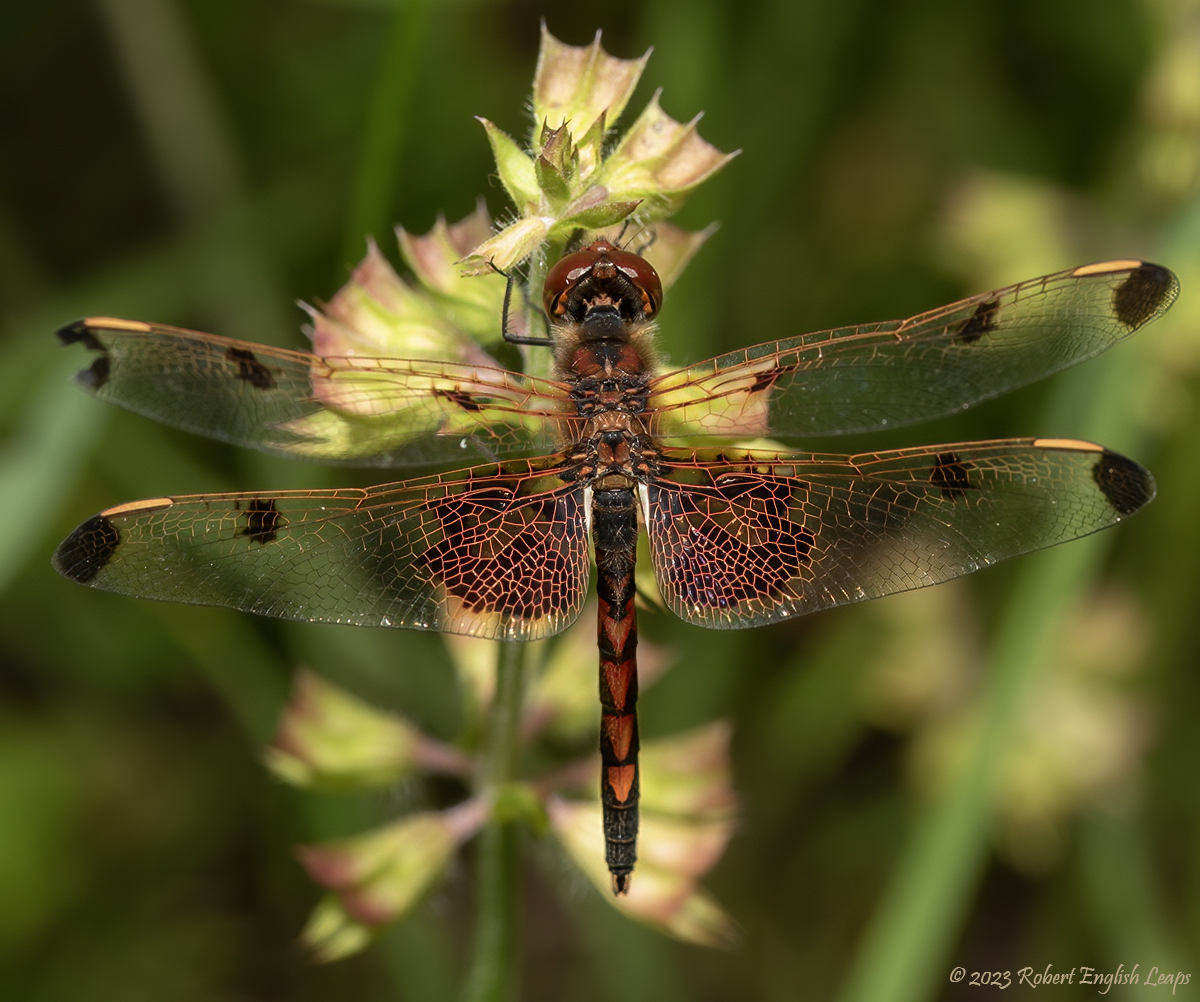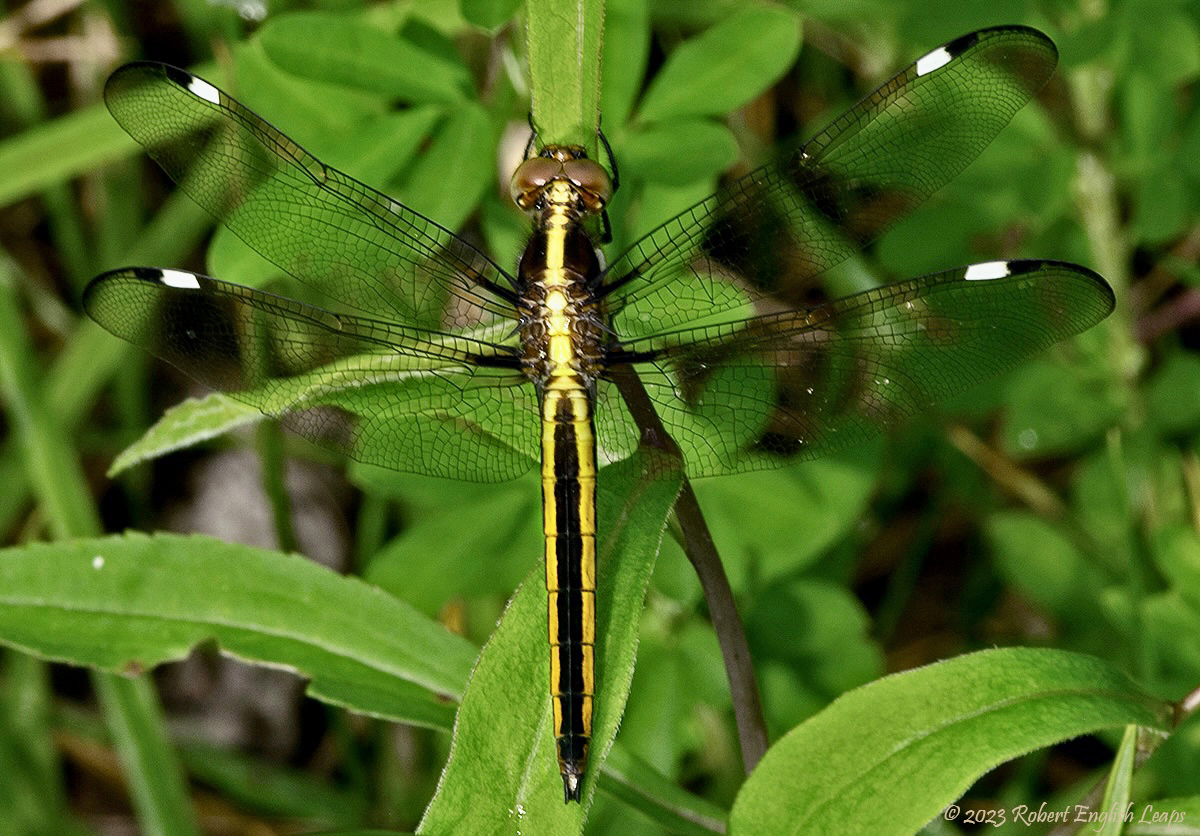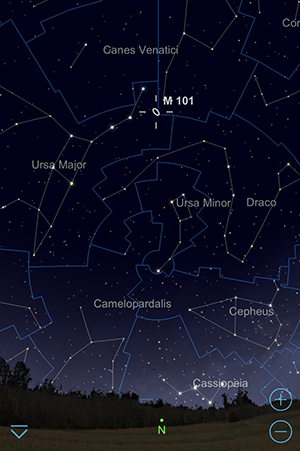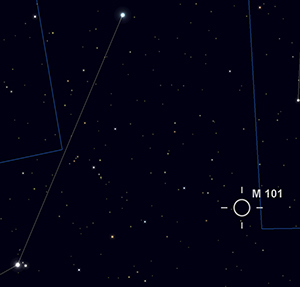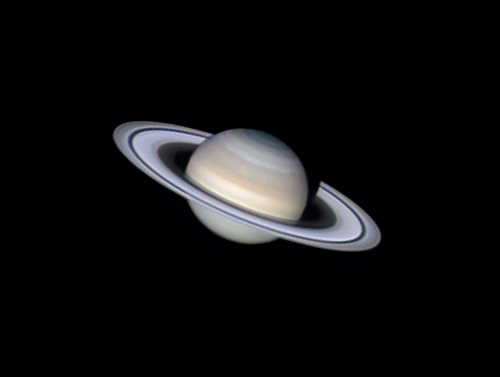The purpose of this feature is to give scout leaders, educators and naturalists an idea of some of the natural events coming up each month. We will try to cover a variety of natural events ranging from sky events to calling periods of amphibians, bird and mammal watching tips, prominent wildflowers and anything else that comes to mind. We will also note prominent constellations appearing over the eastern horizon at mid-evening each month for our area for those who would like to learn the constellations. If you have suggestions for other types of natural information you would like to see added to this calendar, let us know! Though we link book references to nationwide sources, we encourage you to support your local bookstore whenever possible.
Notes From May 2023
I took this image of the pond here at Cloudland just before sunset on May 3rd. The cooler temperatures this month have reduced the number of dragonflies that I've been seeing, but in the small meadow below the pond I photographed two striking species that were new for me at the farm. The species below is a Calico Pennant.
I photographed this immature male Calico Pennant on the morning of May 27th. The females of this species have the central hind wing venation and dorsal spots in yellow rather than red. I probably did not notice this species in past years because I was concentrating on species in the immediate vicinity of the pond. I found these two species in a small meadow below the pond. Males often perch on herbaceous plants in fields near ponds, watching for females. Pairing frequently occurs away from water, and then the male and female fly in tandem to a nearby pond for ovipositing. Both the male and female are striking! Another new and colorful dragonfly species for me this spring was the Spangled Skimmer. I encountered the female shown below on May 23rd, in the same small meadow that I found the Calico Pennant.
There are several species with yellow stripes down the sides of the abdomen but the striking black and white stigmas (stigmas are the rectangular colored patches on the outboard leading edges of the wings) of this species are diagnostic. There are also light-yellow patches on the sides of the thorax. As with the Calico Pennant, habitat can be both at pond edges or in fields near ponds.
On May 19th Japanese amateur astronomer Koichi Itagaki discovered a supernova in the galaxy Messier 101. I heard the news on May 22nd but didn't have a clear sky until the evening of May 25th. By the time I imaged it, it had grown in brightness to about 11th magnitude, bright enough to be seen in relatively small amateur telescopes. I haven't had a completely clear night since the 25th, so I was very fortunate to get that brief clearing of clouds.
Most of the stars in the two charts are visible with binoculars. The galaxy itself has a fairly low surface brightness, so it may be difficult to find from urban skies with the moon visible. The supernova's brightness could fade at any time but may be visible in 6-inch aperture telescope away from city lights. This supernova is a type 2 supernova, meaning it was the result of a core collapse of a star at with at least eight times the mass of our Sun. Nuclear fusion in the core of stars converts lighter elements into heavier elements until the process produces iron. At this point the core cannot support the weight of its outer layers and the core collapses. The outer parts of the core can reach speeds of up to 23% of the speed of light as they fall inward. The shock wave then rebounds with an incredible amount of energy blasting away the outer layers of the star. It's hard to conceive of the amount of energy that is released. The core temperature may rise to 100 billion Kelvins. Any surrounding planets do not survive. The peak luminosity of a supernova can meet or exceed that of an entire galaxy before it fades away. Supernovas provide a chance for an amateur astronomer to photograph or see an individual star from another galaxy, something that is not normally possible. Since Messier 101 is around 21 million light-years distant, we are looking back in time to an event that happened 21 million years ago. The Earth was in the Miocene period. The first dogs and bears appeared at this time, as did the first saber-toothed cats. I hope to get one more clear night to use my telescopes visually to see the supernova. Although you can't see nearly as much detail visually as you can by imaging, it's a special feeling to know that the photons that are tickling the retina of your eyes have completed such a journey.
Sky Events for June 2023: The June Solstice occurs at 10:58am EST on June 21st, marking the summer solstice and the longest day of the year for the Northern Hemisphere.
Morning Sky:
Mercury
will be low in the east before sunrise at the beginning of the month. Look
for it about 30 minutes before sunrise about 7 degrees above the horizon,
about a fist at arm's length below and to the left of brighter Jupiter. It
will gradually sink back in to the morning twilight glow as the month
progresses.
Evening Sky:
Venus
shines bright and high in the west after sunset. Look for it to the left
of the bright stars Castor and Pollux in Gemini at the beginning of the
month.
Mars
continues to fade and drifts across Cancer into Leo this month. Telescopically the
disk of the planet is less than 5 seconds of an arc in apparent diameter,
making surface details very difficult to see. In binoculars you should
still be able to pick up its reddish tint. Constellations:
New constellations this month in the eastern sky are Lyra, the Lyre, with its bright star Vega, Cygnus, the Swan, and Aquila, the Eagle. The bright stars Vega, Deneb and Altair form the "summer triangle." The galaxy Messier 106 hangs below the "Big Dipper" just over the border of Canes Venatici, the Hunting Dogs. Its bright core contrasts with its rather faint spiral arms. My notes show that it was not hard to see in my little 22 power, 60mm spotting scope. In a dark sky you should be able to see it as a very faint misty spot in binoculars. You will want to have either a good star chart or an app like Sky Safari to know where to look. Estimates place it at a distance of 25 million light-years.
On Learning the Constellations: We advise learning a few constellations each month, and then following them through the seasons. Once you associate a particular constellation coming over the eastern horizon at a certain time of year, you may start thinking about it like an old friend, looking forward to its arrival each season. The stars in the evening scene above, for instance, will always be in the same place relative to the horizon at the same time and date each June. Of course, the planets do move slowly through the constellations, but with practice you will learn to identify them from their appearance. In particular, learn the brightest stars (like Altair and Vega in the above scene looking east), for they will guide you to the fainter stars. Once you can locate the more prominent constellations, you can "branch out" to other constellations around them. It may take you a little while to get a sense of scale, to translate what you see on the computer screen or what you see on the page of a book to what you see in the sky. Look for patterns, like the stars that make up the constellation Lyra. The earth's rotation causes the constellations to appear to move across the sky just as the sun and the moon appear to do. If you go outside earlier than the time shown on the charts, the constellations will be lower to the eastern horizon. If you observe later, they will have climbed higher. As each season progresses, the earth's motion around the sun causes the constellations to appear a little farther towards the west each night for any given time of night. If you want to see where the constellations in the above figures will be on July 15th at 10:30pm EDT, you can stay up till 12:30am EDT on June 16th and get a preview. The westward motion of the constellations is equivalent to two hours per month.
Recommended: Sky & Telescope's Pocket Star Atlas is beautiful, compact star atlas. A good book to learn the constellations is Patterns in the Sky, by Hewitt-White. For sky watching tips, an inexpensive good guide is Secrets of Stargazing, by Becky Ramotowski.
A good general reference book on astronomy is the Peterson
Field Guide,
A Field Guide to the Stars and Planets, by Pasachoff. The book retails for around $14.00.
The Virtual Moon Atlas is a terrific way to learn the surface features of the Moon. And it's free software. You can download the Virtual Moon Atlas here. Apps: The Sky Safari 6 basic version is free and a great aid for the beginning stargazer. We really love the Sky Safari 6 Pro. Both are available for iOS and Android operating systems. There are three versions. The Pro is simply the best astronomy app we've ever seen. The description of the Pro version reads, "includes over 100 million stars, 3 million galaxies down to 18th magnitude, and 750,000 solar system objects; including every comet and asteroid ever discovered." A nother great app is the Photographer's Ephemeris. Great for finding sunrise, moonrise, sunset and moonset times and the precise place on the horizon that the event will occur. Invaluable not only for planning photographs, but also nice to plan an outing to watch the full moon rise. Available for both androids and iOS operating systems.
Amphibians:
Recommended: The Frogs and Toads of North America, Lang Elliott, Houghton Mifflin Co. Archives (Remember to use the back button on your browser, NOT the back button on the web page!) Natural Calendar February 2023 Natural Calendar December 2022 Natural Calendar November 2022 Natural Calendar September 2022 Natural Calendar February 2022 Natural Calendar December 2021 Natural Calendar November 2021 Natural Calendar February 2021 Natural Calendar December 2020 Natural Calendar November 2020 Natural Calendar September 2020 Natural Calendar February 2020 Natural Calendar December 2019 Natural Calendar November 2019 Natural Calendar September 2019 Natural Calendar February 2019 Natural Calendar December 2018 Natural Calendar November 2018 Natural Calendar September 2018 Natural Calendar February 2018 Natural Calendar December 2017 Natural Calendar November 2017 Natural Calendar October 2017Natural Calendar September 2017 Natural Calendar February 2017 Natural Calendar December 2016 Natural Calendar November 2016 Natural Calendar September 2016Natural Calendar February 2016 Natural Calendar December 2015 Natural Calendar November 2015 Natural Calendar September 2015 Natural Calendar November 2014 Natural Calendar September 2014 Natural Calendar September 2013 Natural Calendar December 2012 Natural Calendar November 2012 Natural Calendar September 2012 Natural Calendar February 2012 Natural Calendar December 2011 Natural Calendar November 2011 Natural Calendar September 2011 Natural Calendar December 2010 Natural Calendar November 2010 Natural Calendar September 2010 Natural Calendar February 2010 Natural Calendar December 2009 Natural Calendar November 2009 Natural Calendar September 2009 Natural Calendar February 2009 Natural Calendar December 2008 Natural Calendar November 2008 Natural Calendar September 2008 Natural Calendar February 2008 Natural Calendar December 2007 Natural Calendar November 2007 Natural Calendar September 2007 Natural Calendar February 2007 Natural Calendar December 2006 Natural Calendar November 2006 Natural Calendar September 2006 Natural Calendar February 2006
Natural Calendar December 2005
Natural Calendar November 2005
Natural Calendar September 2005
Natural Calendar February 2005
Natural Calendar December 2004
Natural Calendar November 2004
Natural Calendar September 2004
Natural Calendar February 2004
Natural Calendar December 2003
Natural Calendar November 2003 Natural Calendar February 2003 Natural Calendar December 2002 Natural Calendar November 2002 Nature Notes Archives: Nature Notes was a page we published in 2001 and 2002 containing our observations about everything from the northern lights display of November 2001 to frog and salamander egg masses. Night scenes prepared with The Sky Professional from Software Bisque All images and recordings © 2023 Leaps
|
|
